Odell Church Repairs and Additions

Odell church from the north-west in 1868 [Z50/86/59]
Some of the following information is taken from former County Archivist Chris Pickford's Bedfordshire Historical Record Society volume Bedfordshire Churches in the 19th Century: Parishes H-R. The first known additions to the church are fittings installed following a bequest in 1638 by William Alston, who had bought the Odell Castle Estate four years before. These included the screen under the tower, incorporating a ringing loft erected in that year. Three of the bells were recast the following year and plate was obtained. Also Jacobean and so perhaps dating to the same bequest are the altar table, pews and pulpit, complete with hour glass, although the latter was said to have been brought to the church later, in 1654. It is interesting to note that Alston's bequest to beautify the church came just two years after the Rector Peter Bulkley had been ejected from the living due to his Puritanism and gone off to America to help found Concord, Massachusetts.
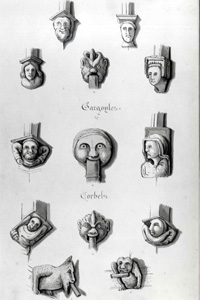
Corbels and gargoyles drawn in 1868 [Z50/86/65]
Minor roof repairs were undertaken in 1789, 1793 to 1798 and 1800 to 1804 [P115/5/1]. The chancel was repaired through a bequest by Sir Rowland Alston in 1758 [BS12]. The 17th century church clock was replaced in 1820 [P115/5/1].
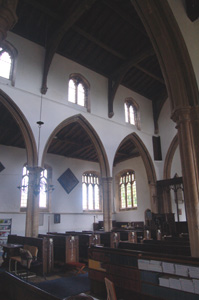
View to north aisle from south aisle June 2008
In 1823 Archdeacon Bonney ordered repairs to the church which were subsequently carried out [P115/5/1] including repairs to the belfry steps in 1827, the windows in 1828, the bells in 1832 and the north aisle 1834 with extensive roof repairs in 1837 - the latter were inspected by Bedford builder Thomas Gwyn Elger who thought them: "very fairly performed as far as they have gone" but advised that more needed doing. At a visitation on a rainy day two years later, Archdeacon Bonney noted that the roof was watertight.

The south door June 2008
John Martin (1791-1855) was the librarian of Woburn Abbey. In the years either side of 1850 he published a series of articles in the Northampton Mercury on the state of Bedfordshire churches under the pseudonym WA. He was a high churchman and often deplored the state of the churches he visited in pompous, snide and acerbic terms. The article on All Saints was published on 22nd July 1854 and so is one of his last, and not one of his most spelentic: "The chancel has an open roof, and is in very good order. The window is partly obscured by some ugly wood panelling. The general appearance of this quarter of the church is marred by two large pews. These disfugurements have been styled, in a recent debate in the House of Commons, as more like "stalls for keeping hunters in, tha seats to accommodate human beings. A large seat of this kind, fitted up with carpet, easy chair &c., is a good illustration of the above comparison. We were told it was about to undergo renovation; we wish we could have said entire demolition".
![The pulpit in 1868 [Z50/86/62]](/CommunityHistories/Odell/Odellimages/Z50-86-62 pulpit in 1868.jpg)
The pulpit in 1868 [Z50/86/62]
"The roof of the nave is timber framed, and the sittings consist for the most part of the original open benches, but surrounded by the enclosed pews of modern days. The backs of these seats are fitted with matting, vainly endeavouring to conceal the ravages of the damp so prevalent, and which this preservative of the occupants' habilaments, only assists in rendering more dangerous. The columns are painted, and as the colour is that of stone, and not fancifully decorated by the village artist, is less objectionable than usual. Some cherubim and the walls of the church have not fared so well. They are well covered with white wash. In the pulpit are the remains of an ancient hour glass, examples of which are becoming daily more rare".

The west end June 2008
The western window is not blocked out, and the ringers are brought in view of the congregation"
![The font in 1868 [Z50/86/60]](/CommunityHistories/Odell/Odellimages/Z50-86-60 font in 1868.jpg)
The font in 1868 [Z50/86/60]
"The font, one of an early period, is sadly disfigured by paint. The lead lining is preserved, but the use of the font is superseded by a piece of crockery. The doorway to the roodloft is blocked up by modern pewing, which also shuts out soem other interesting remains. Hat pegs add their quota to the disfifurement of a building, which, on the whole, is in better condition than many others in the county".
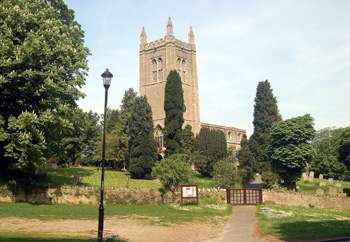
Odell church from the south-west May 2008
"The alms box is convered into a receptacle for rusty keys and mouldering paper. The chuchyard is unlocked, and from the porch, sadly dedaubed with limewash, not having the windows filled up, the traveller can find welcome rest, and a very pleasant prospect; and if a lover of trees, cannot fail to pause on the magnificent chestnut tree, which spreads over the churchyard and the road. there is no national school".

Detail of Christ the Good Shepherd in the chancel east window June 2008
A major restoration of the church began in 1863 with the removal of unfashionable fittings such as the box pews, desk and reredos, which partially obscured the east window. A new organ was placed in the chancel in 1871 [P115/0/2] and the bells re-hung in 1882. The west window was restored in 1888 and the east window filled with stained glass in 1904 in memory of Rev.William Cornish Hunt (rector 1863 to 1891) [P115/2/2/4].

Church interior looking east about 1925 [Z50/86/3]
The south aisle was restored in 1912 partly due to the donation of £300 by: "an American whose ancestors went with the Pilgrim Fathers", in fact it was a descendant of Peter Bulkley. Extensive roof repairs were carried out between 1928 and 1931[P115/2/2/8-9].
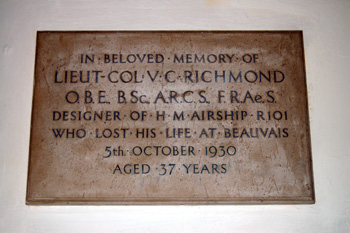
Plaque to Lieutenant-Colonel Richmond June 2008
A memorial was installed to Vincent Crane Richmond, designer of the ill-fated R101 who lost his life when the airship crashed on 5th October 1930. He lived at Odell Rectory. Other 20th century work included re-hanging the bells, again, in 1958, the provision of a new altar table in 1961and creation of a vestry in the north aisle and a meeting room under the tower.
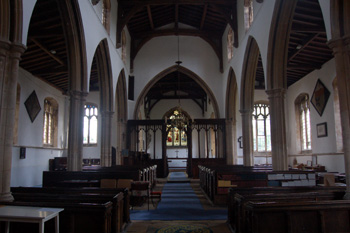
Nave looking east June 2008